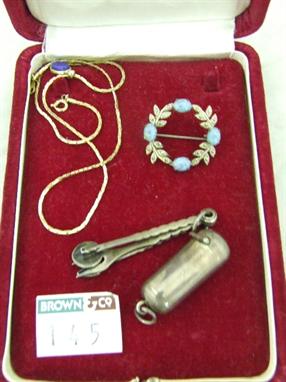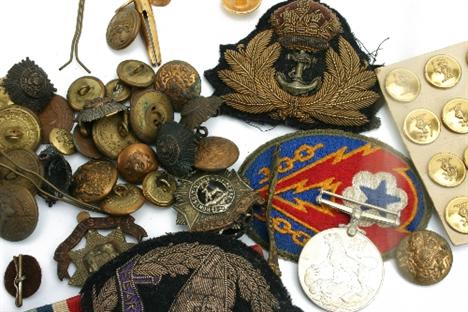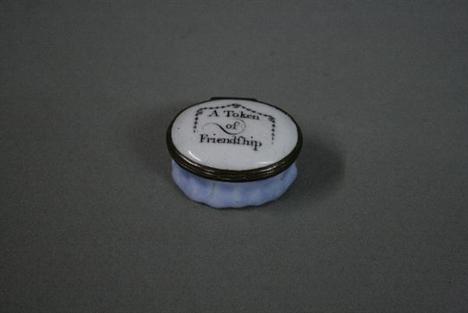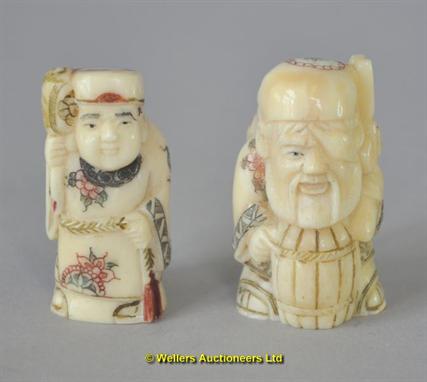We found 24353 price guide item(s) matching your search
There are 24353 lots that match your search criteria. Subscribe now to get instant access to the full price guide service.
Click here to subscribe- List
- Grid
-
24353 item(s)/page
A quantity of collectables, including; a small miniature in a wooden frame, 19th century, a hat pin modelled as a golf club, a silver pen torch, a hunting knife by Joseph Rodgers & Sons, a Chinese carved ivory child`s toy, various apothecary tools in a Victorian papier mache patch box, a silver cased pocket watch by Waltham, a L & N.W.R locomotive badge and sundry.
Cordiner, Rev. Charles Remarkable ruins and romantic prospects of North Britain. London: Peter Mazell, 1788-95. 4to, 2 volumes in one, engraved titles, frontispiece, 116 engraved plates, contemporary red morocco gilt, some rubbing to edges, patch of wear to backstrip, interior clean Provenance: W.S. Adams, bookplate.
Bewick, Thomas The fables of Aesop and others. Newcastle, 1818. 8vo, subscriber`s edition, signed by Bewick, frontispiece, full grained morocco gilt, heavily damp stained on early leaves, frontispiece loose; [Idem] A general history of quadrupeds. Newcastle, 1791. Second edition, full morocco gilt, some dampstaining; [Idem] History of British birds. Newcastle, 1797-1804. First edition, 2 volumes, rude engraving on page 285 [inked over], later full morocco gilt, patch of wear to upper hinge of volume 2, dampstaining; Robinson, Robert Thomas Bewick his life and times. Newcastle, 1887. 4to, frontispiece, original green cloth, boards and early leaves heavily dampstained; and a selection of leaflets relating to Bewick. Sold not subject to return. (9)
A WWI WAAC khaki shoulder strap, embroidered WAAC, red central band; a pair RNVR Electrical Engineer Commander’s shoulder boards; a “Q” ship gunner’s red on blue arm badge; 2 PO’s embroidered badges, RN red and WRNS blue; an RAF pilot’s wings on cloth with WWI etc medal ribbons; a crown/eagle embroidered on black; a pair Desert Air Force red on buff eagle shoulder flashes; an Airborne Division, India, shoulder patch; an RAF Observer’s wing. GC
A scarce .45” Sharps Patent falling block breech loading percussion target rifle, 42” overall, heavy octagonal barrel 26” with dove tail and stud for rearsight (now missing) and stamped on the top flat “Sharp’s Rifle Manufg. Co. Hartford, Conn”, back action lock with pellet primer, the plated stamped “Sharp’s Patent 1852”, the frame tang similarly stamped and numbered 11060, double set triggers, walnut halfstock with pewter fore end cap, the butt with hinged patch box. GWO & C (metalwork lightly worn and pitted overall, large repair to butt, frame tang drilled for rearsight, one screw hole in the centre of the tang marking). Plate 11
A collection of small silver and plated items, including a Victorian silver octagonal mustard pot by Latham & Morton, Birmingham 1898, with blue glass liner, 6cm high, 2.6oz; two silver mounted cut glass ink pots, Birmingham 1898 and 1903; a small patch box, 18th century; a Victorian silver mount from a claret jug, Sheffield 1873; and other items
Nelson Interest: A South Staffordshire Enamel Patch Box, circa 1798, of oval form, the white enamelled lid with inscription WHERE CAESAR AND ALEXANDER FOUGHT BRAVE NELSON`S FLEET NEW WONDERS WROUGHT, a mirror to the underside of the lid, with pink tinted body enamel, 4.5cm wide The four line verse bears reference to The Battle of the Nile, Aboukir Bay, near Alexandria, Egypt, 1 & 2 August 1798. Also, The Battle of the Nile (47BC) Julius Caesar and Cleopatra`s combined Roman-Egyptian armies defeat Queen Arsinoe IV and King Ptolemy XIII and secure the throne of Egypt. Alexander the Great spent several months in Egypt as part of his campaigns against the Persian Empire of Darius III.
Bewick (Thomas). Bewick Gleanings: Being Impressions from Copperplates and Wood Block, Engraved in the Bewick Workshop ... edited, with notes, by Julia Boyd ..., to which are added, Lives of Thos. Bewick and his Pupils, pub. Andrew Reid, Newcastle, 1886, port. frontis., b & w illusts., t.e.g., recent endpapers, contemp. morocco gilt, spine slightly worn, small patch repair to upper board, 4to. Large paper copy, no. 29 of an unspecified limitation, signed by Julia Boyd. (1)
Four: 1914-15 star (8153 Vol C H G Nida, Bombay Vol Rif); BWM and Victory (Lieut, RAF), Defence Medal (un-named as issued to Warden ARP), GVF. Most attractively framed with photo of recipient; Bombay VR title, RFC cap badge; MGC badge; 2 ARP badges, RAF 1st type cap badge and pair eagle cuff badges. A second frame displays pr RFC collars, RAF collars and buttons, and recipient’s ID bracelet. A futher frame shows 4 Bombay Volunteer Rifles buttons, 2 MGC titles and “M” title, and a khaki embroidered “Motor Machine/Guns” cloth patch (25th MMG Bty, Calcutta Volunteers Middle East Oct 1916-Aug 1917). A framed Commission to Charles Henry George Nida, RAF, 1st April 1918 as Lieut; with recipient’s goggles, tie, photo of Nida in RFC uniform; a manuscript exercise book “Engines. Book 2” with some drawn diagrams (cover part detached); various photocopies of service documents and an interesting duplicated chapter from his autobiography- “Chapter Ten - Flying Corps Escapades” in which he describes his learning to fly and the death of his friend through a flying accident in Egypt. Note: Charles Henry George Nida, born Paris 1895 to an English mother and French father. The family later moved to Streatham and in 1912 Nida went to India as a travelling salesman for a clothing firm. At the outbreak of WWI he Volunteered for service with the Bombay Volunteer Rifles and went with them aboard HMIS Hardinge in an attempt to intercept the German ship Emden. The Bombay V Rifles became the Bombay Motorised Machine Gun Corps and he took a commission as Lieutenant. In 1917 he transferred to the RFC and trained as a Pilot at the 23rd Training Squadron based at Alexandria. He saw service fighting the Turks before being stationed with No 8 Sqdrn in France. He left the RAF in 1920 to become a journalist. During WWII he became a Warden in the ARP in Edgeware. He died in 1985.
A Third Reich 2nd pattern Luftwaffe officer’s dagger, with unmarked plated blade (lightly rusted 1” patch to tip) and wire bound orange plastic grip, in its sheath with hanging straps. Basically GC (metalwork rather dirty overall with some corrosion, the fabric of the hanging straps very worn)
Bruncy (Pierre) The Greek theatre. translated by Mrs. Charlotte Lennox, 3 vol., first edition, errata leaf at the end of vol.3, contemporary red morocco, gilt spines with ornaments forming a saltire pattern perhaps suggest a Scottish binding, small chip at head of one spine, and one turn-in lifting, one patch of surface abrasion, otherwise an attractive copy, [Fleeman 60.2LB], 4to, 1759. ***Samuel Johnson contributed the dedication and translations of the dissertation upon Greek comedy and the general conclusion..
A GROUP OF OBJECTS OF VERTU 18TH CENTURY Comprising a French gold-mounted grey-green laquer carnet-de-bal, the cover inscribed 'SOUVENIR' and 'D'AMITIE', chased gold mounts marked Paris, with the charge and discharge marks of Julien Alaterre, 1768-1774, makers mark and date letter indistinct, containing a four-leaf ivory tablet and gold-capped pencil, polished gold push-piece; together with, three rectangular gold-mounted ivory carnets-de-bal, probably English circa 1770, one set with enamel-bordered oval plaque with gold initial 'S' surmounted with an earl's coronet on obverse, a similarly bordered oval plaque containing plaited hair on reverse, the cover applied with gold plaques inscribed 'Souvenir' and 'Cheri', apparently unmarked chased gold mounts, containing a five-leaf ivory tablet, polished gold push-piece; another, set with pierced gold-bordered oval glazed plaque with gold monogram on reverse, glazed plaque on obverse, the cover applied with pierced gold inscription 'SOUVENIR' and 'D'AMITIE' within pierced reeded gold borders with foliate garlands, apparently unmarked chased gold mounts, containing a three-leaf ivory tablet, polished gold push-piece; another, with polished gold mounts, containing a seven-leaf ivory tablet and pencil, polished gold push-piece; together with, a gold-mounted ivory eye glass, probably English circa 1770/1780, apparently unmarked gold mounts chased with anthemium pattern in green gold, together with, a gold-mounted navette-shaped patch-box or toothpick case, probably English circa 1770/1780, the cover and base set with glazed panels containing hairwork, the apparently unmarked gold mounts chased with palm leaf and vitruvian scroll patterns in green gold, polished gold-lined interior, together with, a gold-mounted hardstone paper knife, probably English, early 18th Century, grey and brown agate handle enclosed within with pierced gold cagework decorated with hunting scene and rocaille, the base with gold rosette, silver-gilt blade 2¾in. (70mm.) to 6 5/8in. (170mm.) (7) View on Christie's.com
A GEORGE III ENAMEL OVAL PATCH BOX, SOUTH STAFFORDSHIRE the lid transfer printed in black with St Paul`s Cathedral and inscribed A Trifle from LONDON, a steel mirror to the underside, the base light blue, 4cm w Tiny crack on extreme left of lid; typical localised rust on the mirror but in excellent overall condition; much above average; no restoration
AN OTHER RANK`S FULL DRESS TUNIC AND PANTALOONS, 11TH (PRINCE ALBERT`S OWN) HUSSARS, 1907 & 1913 the tunic of dark blue wool embellished with yellow cotton square-cord around the edges, on the breast in the form of six loops with trefoil drops at the ends, on each of the two back seams with a single line having three eyes at the top and an Austrian knot at the bottom and on the cuffs with an Austrian knot; six brass ball buttons at centre-front; with paper Royal Army Clothing Factory label dated 1907 inside; lacks collar badges; lining detached inside right breast; the pantaloons of crimson wool with a 4.5cm; 1¾in wide stripe of yellow cotton lace with a central narrow scarlet train on the outer seams and an oval patch of scarlet reinforcing cloth inside each knee, metal fly and braces buttons; with paper Royal Army Clothing Factory label dated 1913
A FINE CASED 16 BORE PERCUSSION DOUBLE RIFLE BY JAMES PURDEY, 314 1/2 OXFORD STREET, LONDON, NO. 3202 FOR 1838 with browned twist sighted barrels signed on the flat, rifled with ten grooves and fitted with folding back-sight, engraved case-hardened breech inlaid with a platinum line, platinum plugs, scroll-engraved case-hardened tang, signed detented engraved case-hardened locks decorated with scrolling foliage, fitted with blued safety-catches and engraved case-hardened hammers, figured walnut half-stock, cut with a panel of chequering over the fore-end (areas of minor bruising) and the grip, cast-off butt for left-eyed sighting, fitted with an early cheek pad, probably the original, scroll-engraved steel mounts comprising blued trigger-guard cut with chequering over the rear finial, blued chequered butt-cap, fore-end cap, and barrel bolt escutcheons, engraved case-hardened patch-box-cover, original brass-tipped ramrod, and retaining much original finish throughout: in its original fitted mahogany case lined in green baize (light wear and fading, some compartments detached, the accessory box damaged and incomplete), the lid fitted with brass flush-fitting carrying handle (cracked, scratches and minor chips), and with trade label on the inside (small holes), complete with a number of original accessories including mallet, wad cutter, spru-cutter, bullet starter, brass shot and powder measure and cleaning wad contained in a turned polished bone box, and complete with its leather outer case (one handle missing) 74cm; 29 1/8in barrels Provenance Robert Dillon, 3rd Lord Clonbrock (1807-1893). Literature L. Patrick Unsworth, The Early Purdeys, London 1996, p. 154. Dillon was educated at Eton and Oxford and inherited his large estate at Clonbrock, County Galway at the relatively young age of 19. In addition to being a skilled agriculturalist, a keen gardener and an innovative forester he was a passionate sportsman. He was Master of the Heythrop Hunt, regularly fished for salmon at Castleconnell but his greatest love was shooting. In his late 20`s a guest at one of his shooting parties took a low shot at a woodcock and blinded him in the right eye. However, the accident did not deter him and he ordered a whole series of new guns including the present double rifle. He continued shooting well into old age and, when he had grown too old to go out, he apparently used this rifle to shoot fallow bucks in the park at Clonbrock from the library window. The Purdey records state that this was made for the left eye, 30th July 1838, for £84. The majority of Purdey rifles during this period were supplied cased in mahogany complete with accessories, however the majority of outer covers were regarded as extras.
-
24353 item(s)/page















































